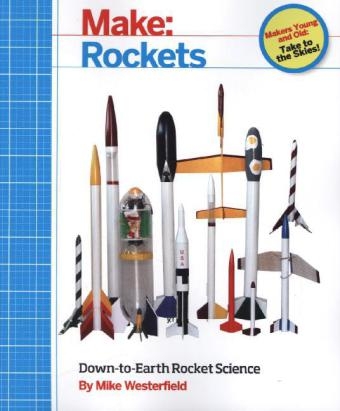
Make: Rockets
O'Reilly Media (Verlag)
978-1-4571-8292-1 (ISBN)
This book teaches the reader to build rockets - powered by compressed air, water, and solid propellant - with the maximum possible fun, safety, and educational experience.
»Make: Rockets« is for all the science geeks who look at the moon and try to figure out where Neil Armstrong walked, watch in awe as rockets lift off, and want to fly their own model rockets.
Starting with the basics of rocket propulsion, readers will start out making rockets made from stuff lying around the house, and then move on up to air-, water-, and solid propellant-powered rockets.
Most of the rockets in the book can be built from parts in the Estes Designer Special kit.
Mike Westerfield sold his car and rode a bike for several months to raise cash to buy an Apple II computer, then used it to write ORCA/M, which went on to become Apple Programmer's Workshop, the Apple-labeled development environment for the Apple IIGS. Since then Mike has developed numerous compilers and interpreters, software for mission-critical physics packages for military satellites, plasma physics simulations for Z-pinch experiments, multimedia authoring tools for grade schoolers, disease surveillance programs credited with saving lives of hurricane Katrina refugees, advanced military simulations that protect our nation's most critical assets, and technical computing software for iOS. Mike currently runs the Byte Works, an independent software publishing and consulting firm.
Chapter 1Let’s Fly Some Rockets!
Shopping List
The Match Head Rocket
Balloon Rockets
Air Rockets
Chapter 2Model Rocketry Today
The Five Faces of Hobby Rockets
Solid Propellant Rocket Motors
A Typical Model Rocket and Its Flight
Let’s Get Started!
Chapter 3Juno: A Solid Propellant Rocket
Parts and Tools
Building the Rocket
Options
Chapter 4Launch Pads
What Makes a Good Launcher?
A Quick Lesson in Igniters
The Mono Launcher
The Mono Launch Controller
The Quad Launch Pad
The Quad Launch Controller
Chapter 5Flight Operations
Picking a Launch Site
Packing for the Launch
Range Operations
Site Setup
Preparing the Rocket
The Launch
Recovery
Chapter 6Compressed Air Rockets
Building an Air Rocket Launcher
Building Ballistic Air Rockets
Flying Air Rockets
Chapter 7Rocket Stability
What Is Stability?
Experimenting with Stability
Checking Stability with the String Method
Checking Stability Experimentally
Checking Stability with Math
Further Reading
Chapter 8How High Did It Go?
The Single-Axis Tracker
Dual-Axis Tracking
Altimeters
Comparing the Methods
Chapter 9Payloads
Liftoff Weight
Juno Payload Conversion
The Ceres Payload Rocket
The Ceres A Booster
The Ceres B Booster
The Thin Man and ICU Payload Bays
The Fat Man Payload Bay
The Over Easy Payload Bay
The ICU2 Payload Bay
Chapter 10Selecting Parachutes and Streamers
How Fast Should a Rocket Fall?
Streamers Versus Parachutes
Streamer Design
Thoughts on Parachute Material
Parachute Selection Tables
Parachute Physics
Chapter 11Water Rockets
The Launcher
Themis: A Ballistic Water Rocket
Flying Water Rockets
Chapter 12Parachute Recovery of a Water Rocket
Building the Water Rocket Parachute System
Flying Themis with a Parachute
Chapter 13Subsonic Aerodynamics
Reynolds Number and Viscosity
Mach Number
High Reynolds Number Drag
Kind of a Drag: The Three Types of Drag
The Importance of Streamlining
Understanding and Reducing Drag on a Model Rocket
Example: The Coefficient of Drag for Juno
Further Reading
Chapter 14How High Will It Go?
Predicting Altitude Using Physics
Predicting Altitude with a Rocket Simulator
Comparing Simulators to Flight Data
Chapter 15Minimum-Diameter Rockets
Hebe: Skinny Rockets Fly Faster and Higher
Chapter 16Mini-Rockets
Toutatis: The Powerful Midget Rocket
Eros: A Small Rocket That Flies High
Chapter 17Multistage Rockets
The Two-Stage Romulus
Chapter 18Cluster Rockets
Things to Consider When Clustering Rockets
The Three-Motor Cerberus
The Ceres C Booster
Chapter 19Helicopter Recovery
Nicomachus
Chapter 20Rocket and Boost Gliders
Rocket-Powered Aircraft
Icarus
More About Rocket Gliders
Chapter 21Air Rocket Glider
Daedalus
Chapter 22Rocket Clubs and Contests
National Association of Rocketry (NAR)
Tripoli Rocketry Association (TRA)
Local Clubs
Canadian Association of Rocketry (CAR)
Team America Rocketry Challenge (TARC)
Chapter 23Onward and Upward
Reloadable Motors
Designing Your Own Rockets
Odd Rockets
The Outer Limits
Appendix Programs from the Book
Juno Simulation
SRockS
Theodolite
Appendix Places to Buy Stuff or Find Information
Model Rocket Parts and Supplies
Clubs and Information Websites
Electronics Parts and Supplies
General Supplies and Hardware
Appendix The Projects in This Book
The Rockets
The Launch Pads
Trackers
Science and Math
Appendix The NAR Model Rocket Safety Code
| Erscheint lt. Verlag | 21.10.2014 |
|---|---|
| Verlagsort | Sebastopol |
| Sprache | englisch |
| Maße | 203 x 247 mm |
| Gewicht | 1182 g |
| Einbandart | kartoniert |
| Themenwelt | Sachbuch/Ratgeber ► Freizeit / Hobby ► Heimwerken / Do it yourself |
| Sachbuch/Ratgeber ► Natur / Technik ► Technik | |
| Technik ► Fahrzeugbau / Schiffbau | |
| Technik ► Luft- / Raumfahrttechnik | |
| Technik ► Maschinenbau | |
| Schlagworte | Hobby; Modellbau • Maker • Raketenbau |
| ISBN-10 | 1-4571-8292-0 / 1457182920 |
| ISBN-13 | 978-1-4571-8292-1 / 9781457182921 |
| Zustand | Neuware |
| Haben Sie eine Frage zum Produkt? |
aus dem Bereich


